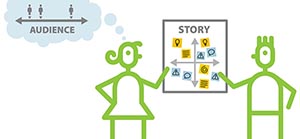When I look back at ThoughtForm’s projects from 2016, much of our conversations with clients were about sharing their story in the right way to reach their audiences. Whether the story was about bringing a new product or service to the market, creating organizational change, or implementing a new process, our clients typically knew the key elements of their stories. But, they were struggling with something equally as important as key plot points: getting the alignment, clarity, and visuals they needed to feel confident in effectively communicating the story.
During our Vision Catching® sessions with clients, we often use different techniques to align and better understand our clients’ challenges, audiences, and stories. But to plan a successful session, we first must identify the gaps and additional information that we need to explore. In talking with our clients early on, we try to understand the change that is necessary for success—essentially, where are they now and where do they want to go?
In a previous post, my colleague Marisa Boevers explained how Boston Boxes can be used to prioritize and evaluate initiatives in a consistent and structured way. Boston Boxes plot one variable on the x-axis, plot another one the y-axis, and then divide the entire chart into quadrants to help discuss possibilities. Originally, this exercise was used by the Boston Consulting Group to assess a company’s market position relative to others in terms of product range.
But, Boston Boxes aren’t only for prioritizing initiatives or growth opportunities. They can often be helpful for identifying gaps or opportunities in a company’s story by using the two axes to explore different points of view for each of your audiences. By doing this, you and your team can force yourselves to get outside of your current thinking and quickly uncover elements that your new or revised story needs to include (or remove) for each (or all) of your target audiences.
For example; at ThoughtForm, we used this technique as part of our internal pre-meeting planning for a client who wanted to share how their software, data management, and processes make them a best-in-class transportation spend management partner. We knew that much of the core story was there, but it was told based on the points of view of each internal team—not the customers’ points of view. Sound familiar? So, to help us better plan our kickoff meeting exercises, the ThoughtForm team explored the client’s software/process (axis 1) and if it was a differentiator/table-stakes (axis 2). From there, we were able to help the team quickly prioritize the focus of our discussions.
Now, let’s say that you’re launching a new internal training effort and want to identify potential barriers or motivators for your audiences. You could use this technique and ask yourself “what makes them want to do/not do this?” (axis 1 = do it/not do it) against “who are we trying to train?” (axis 2 = operational employees/sales teams). Then, you could use cards or sticky notes to explore each quadrant and potentially expose key messages, communication channels, background context, or other elements that you should include in your communications about your training effort.
If you try this on your own, it is often helpful to do this a couple of times using different axes—and perhaps for each of your key audiences as well. Here is a starter list of possible axis options to help you create Boston Boxes of your own:
• Internal/external
• Easy/hard
• Short-term/long-term
• Tactical/strategic
• Visuals/words
• Sales-focused/operations-focused
• Must have/nice to have
• Standard/custom
As you work through this exercise, here are a few questions you can ask yourself to help uncover gaps or potential ideas to include:
• What sort of context or background is necessary or not necessary?
• What level of detail is appropriate for this audience?
• What risks or challenges need to be mitigated?
• What sort of media or communication channels will be effective?
And while this is often a great group exercise, it is sometimes helpful to do this on your own—just to focus your own thinking. If you are planning to use this with your team or with a group, try doing a dry-run on paper on own your own first. Try different axes until you’ve matched up two that you feel can stimulate some good discussion.
Of course this is just one of many methods that can help make your messages more clear, meaningful, and visual.
Nancy Herzing is a strategist, designer, and shareholder at ThoughtForm. She enjoys collaborating with a range of clients, from Fortune 500 corporations to small start-ups, to create and hone communication efforts of all sizes

